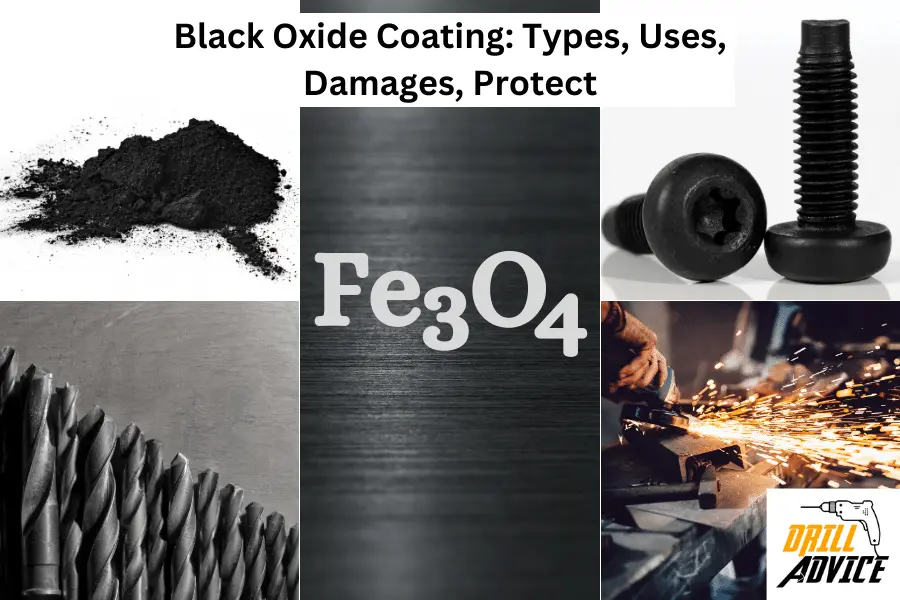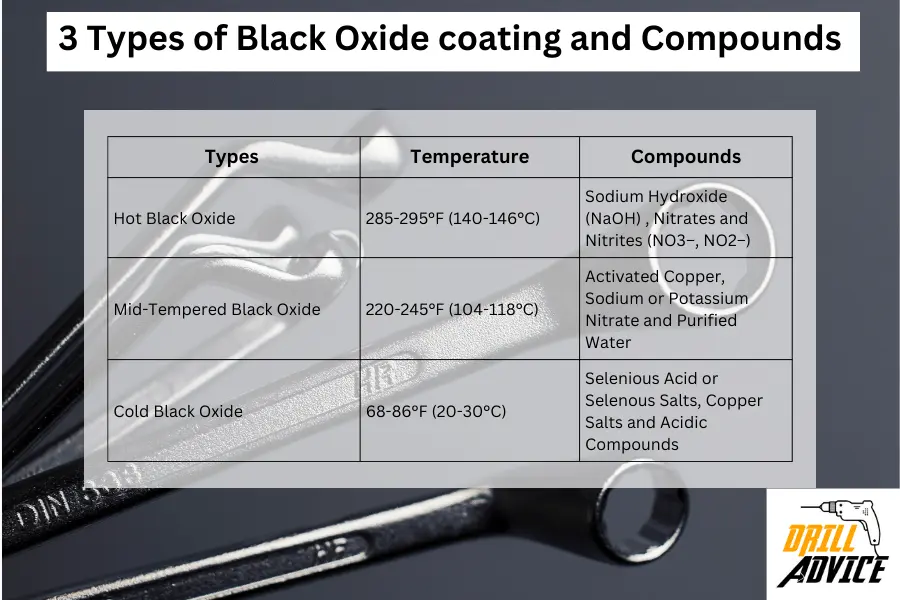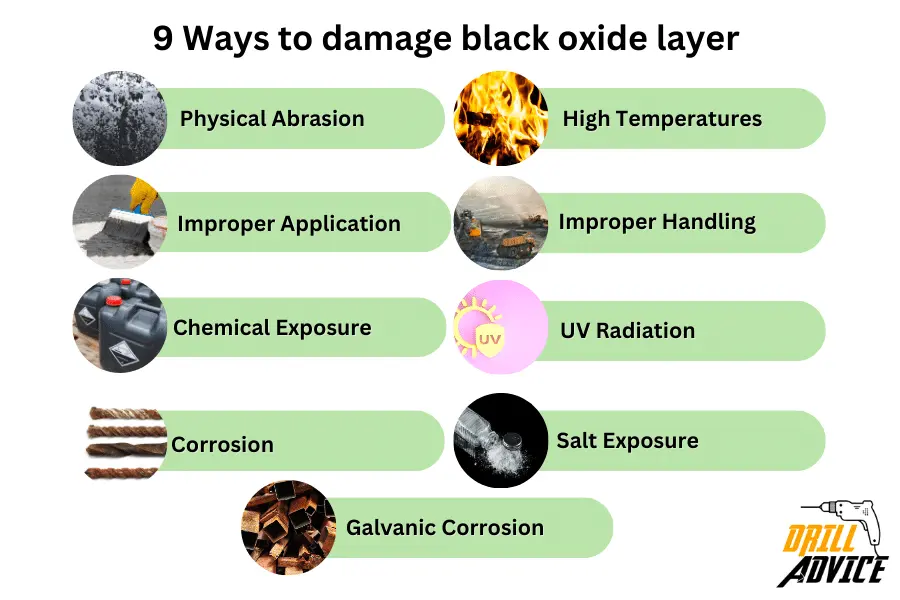
Black Oxide is a black-colored Fe3O4 layer with approximately 1 μm thickness on the metal surface. The black oxide coating is mainly 3 types such are hot black oxide, mid tempered black oxide and cold black oxide.
Hot black oxide coatings are used to add mild corrosion resistance and minimize light reflection. Mid-tempered black oxide is used to produce a black oxide finish on ferrous materials without the boiling temperatures associated with the hot black oxide process. The cold black oxide coating is used on higher temperature-affected objects. All of these types are applied to ferrous metals.
Black oxide has a wearing resistance, corrosion resistance, less light reflection, lubricity, and aesthetic appearance. Hence black oxide coating is mostly used in drill bits, cutting tools, military equipment, automotive products, and medical instruments. The advantages of black oxide are less corrosive, higher wearing and tearing resistance, less reflection, cost-effectiveness, high heat dissipation, and conductivity.
But the black oxide layer can be damaged when the layer is removed by these 7 reasons, such as scratching, abrasion, chemical exposure, exposure to high temperatures, UV radiation, and salt exposure. You can protect the black oxide layer by using for proper application using post-treatment sealants, limit to exposure to harmful chemicals, and store properly.
What is Black Oxide Coating?
The Black Oxide coating is a Fe3O4 layer with black color which is a result of a chemical reaction between the ion of the surface of the ferrous metal and the oxidizing salts. The black oxide coating can reduce the light reflection, increase the corrosion resistance and improve the lubricity.
Black oxide, blacking, oxidizing, oxidising, and gun bluing are referred to the same name for the black oxide layer. The standard black oxide is Fe3O4 which is better than red Fe2O3. Black oxide coating are 3 main types such as hot black oxide, mid-temperature black oxide, and cold black oxide. Each of these black oxide coatings is applied on different temperature ranges. Hence these characteristics and properties are varied.
What is the Thickness of the Black Oxide Layer?
The thickness of the black oxide layer is approximately 1 μm on the metal surface. This minimal thickness change is one reason why it’s favoured for parts where tight tolerances and difficulties.
What are the 3 Types of Black Oxide Coatings?

The main 3 types of black oxide coating are hot black oxide, mid-tempered black oxide, and cold black oxide. These 03 types are used for ferrous metals.
1. Hot Black Oxide
Hot Black Oxide is the most common method of producing a black oxide coating on steel. Here’s a detailed description of hot black oxide.
1. Temperature for Hot Black Oxide: Hot Black Oxide typically operates at a temperature range of 285-295°F (140-146°C).
2. Compounds for Hot Black Oxide: The compounds of hot black oxide are Sodium Hydroxide, and Nitrate and Nitrites.
- Sodium Hydroxide (NaOH): NaOH acts as a cleaner during the process, ensuring the metal surface is free from oils and contaminants.
- Nitrates and Nitrites (NO3–, NO2–): Nitrates and nitrites are oxidizing agents for the hot black oxide process. It can increase the reaction between the iron in the steel and the chemicals to produce the black iron oxide (magnetite, Fe3O4) finish.
3. Process of Hot Black Oxide:
- Preparation: Before the actual black oxide process, parts need to be cleaned thoroughly to remove any dirt, grease, or oil. This can be done using an alkaline cleaner or an acid pickling process.
- Black Oxide Bath: Once cleaned, parts are immersed in the hot black oxide solution. The combination of chemicals and the high temperature causes a chemical reaction that forms a layer of black iron oxide on the part’s surface.
- Rinsing: After the black oxide bath, parts are rinsed with water to remove any residual chemicals.
- Post Treatment: The blackened parts are typically then immersed in a finishing bath, usually an oil or wax, to seal the black oxide and enhance its corrosion protection capabilities. The finishing bath can also improve the part’s appearance, making it glossier or shinier, depending on the desired outcome.
4. Time for Hot Black Oxide: The immersion time in the hot black oxide bath can vary depending on the specific process, the type and thickness of the material, and the desired finish quality. The typical immersion times range from 10 to 30 minutes.
2. Mid-Tempered Black Oxide
Mid-Temperature Black Oxide (often referred to as “Mid-Temp Black Oxide”) offers a safer and more energy-efficient alternative to the hot black oxide process. It’s used to produce a black oxide finish on ferrous materials without the boiling temperatures associated with the hot black oxide process.
1. Temperature for Mid-Temperature Black Oxide: Mid-Temperature Black Oxide typically operates within a temperature range of 220-245°F (104-118°C).
2. Compounds for Mid-Temperature Black Oxide: Below 3 chemicals are used in the mid-temperature black oxide coating.
- Activated Copper: Helps to catalyze the black oxide formation.
- Sodium or Potassium Nitrate: Acts as the primary oxidizer.
- Purified Water: Serves as the solution base.
Note: The exact composition can vary based on the proprietary nature of specific commercial solutions.
3. Process of Mid-Temperature Black Oxide:
- Preparation: Parts should be cleaned to remove any dirt, grease, or oil. This can be achieved using an alkaline cleaner or other cleaning methods.
- Black Oxide Bath: Cleaned parts are immersed in the mid-temperature black oxide solution. The chemicals in the solution react with the metal surface to produce a layer of black iron oxide.
- Rinsing: After the bath, parts are rinsed with water to eliminate any residual chemicals.
- Post Treatment: Similar to hot black oxide, the parts are often immersed in a post-treatment bath (like oil or wax) to enhance the black oxide’s corrosion resistance, lubricity, and appearance.
4. Time for Mid-Temperature Black Oxide: For the mid-temperature black oxide process, immersion time can vary. But is generally shorter than the hot process. Typical immersion times can range from 5 to 20 minutes, depending on factors like the material and desired finish quality.
3. Cold Black Oxide
Cold Black Oxide ( referred to as “Room-Temperature Black Oxide” or “Cold Bluing”) is a process used to produce a black oxide finish on ferrous materials at near ambient temperatures. The process is especially valuable for parts that might be negatively affected by the higher temperatures of other methods.
1. Temperature for Cold Black Oxide: Cold Black Oxide is carried out near room temperature, typically within a range of 68-86°F (20-30°C).
2. Compounds of Cold Black Oxide: Below 3 compounds can be used for cold black oxide.
- Selenious Acid or Selenous Salts: Often used as an oxidizing agent.
- Copper Salts: Can serve as catalysts or activators.
- Acidic Compounds, Such as phosphoric acid, can help clean and etch the metal surface.
Note: Cold black oxide solutions are generally more acidic than their hot or mid-temperature counterparts.
3. Process for Cold Black Oxide:
- Preparation: Parts must be thoroughly cleaned to remove contaminants like dirt, grease, or oil. Acid cleaning or other methods might be employed.
- Black Oxide Bath: Once cleaned, parts are immersed in the cold black oxide solution. The chemicals react with the metal surface to form a layer of black oxide.
- Rinsing: After the chemical treatment, parts are rinsed to remove any residual solution.
- Post Treatment: To improve the durability and corrosion resistance of the finish, parts are often treated with a rust preventive oil, wax, or other sealant.
4. Time for Cold Black Oxide: The reaction time for cold black oxide is typically longer than hot or mid-temperature processes. Immersion times can range anywhere from 20 minutes to several hours, depending on the material, solution strength, and desired finish quality.
What Are the Applications of Black Oxide?
Black oxide has specific characteristics such as corrosion resistance, less light reflection, and lubricity. Therefore black oxide is used for military applications, cutting and drilling tools, the aerospace industry, the automotive industry, decorations, jewellery and arts, sporting goods, and medical instruments widely.
- Firearms and Weaponry: Black oxide is commonly used to provide a corrosion-resistant finish to guns and other weapons.
- Automotive Components: Parts like gears, fasteners, and other components can be black oxide coated to enhance appearance and corrosion resistance.
- Tools: Hand tools, drill bits, wrenches, pliers, and other metal tools can be treated with black oxide to reduce glare, improve grip, and resist rust.
- Aerospace: Certain components in aerospace applications might be black oxide coated for appearance, corrosion resistance, and to reduce light reflection.
- Bearings and Gears: In addition to improving appearance, black oxide can offer enhanced lubricity, reducing wear and increasing the lifespan of moving parts.
- Architectural and Decorative Uses: Architectural elements like metal railings, fixtures, or decorative metalwork can be black oxide coated for aesthetic appeal.
- Electrical Components: Black oxide can help reduce reflection and enhance the appearance of electrical connectors and other components.
- Jewellery and Art: Artists and jewellers use black oxide for patinating copper, brass, and sterling silver to give an antique or contrasting finish to their creations.
- Sporting Goods: Items like golf clubs and other sports equipment can be black oxide coated to improve their appearance and reduce light reflection.
- Medical Instruments: Black oxide can reduce glare from surgical and medical instruments, making them easier to use under bright operating lights.
- Military Equipment: From parts of vehicles to personal equipment, black oxide can be used for camouflaging, reducing reflection, and improving appearance.
- Precision Instruments: Instruments like calipers, gauges, and other measurement tools are often black oxide coated to reduce glare and improve their visual appeal.
Read More About – Hardened Steel: Hardening Methods, Properties, and Uses
What are the 10 Advantages of Black Oxide?
The most important advantages of black oxide are an aesthetic improvement, no shape change after coating, less friction, mild corrosion, cost-effective, removable surface, high heat dissipation, and conductive layer.
- Aesthetic Improvement: Black oxide provides a uniform, sleek, and attractive black finish to metal parts.
- No Dimensional Change: The black oxide process adds a negligible amount of thickness (typically around 0.00005 inches or less) to the treated parts.
- Improved Lubricity: Black oxide can improve the lubricity of metal surfaces, reducing friction and wear, particularly when combined with post-treatment sealants or oils. This can be beneficial for moving parts like gears or bearings.
- Mild Corrosion Resistance: Black oxide has a certain protection against rust.
- Reduced Light Reflection: Black oxide significantly reduces glare and light reflection from metal surfaces.
- Cost-Effective: Black oxide is an inexpensive coating considering other types of coatings.
- Adhesive Surface: The black oxide surface can be removed any time for further usage.
- No Risk of Hydrogen Embrittlement: The black oxide process doesn’t carry the risk of hydrogen embrittlement. This phenomenon can weaken high-strength steel.
- Heat Dissipation: Black surfaces can dissipate heat more effectively than shiny surfaces, which can be beneficial in specific applications requiring heat radiation.
- Conductive Layer: The black oxide layer retains the electrical conductivity of the base metal, which can be essential for specific electrical and electronic applications.
How is Black Oxide Layer Damaged?

The black oxide layer can be damaged or compromised due to various reasons such as scratching, abrasion, chemical exposure, high temperature, UV radiation, and salt exposure.
- Physical Abrasion: Black oxide layers are thin, hence friction or abrasive actions can easily damage the coating.
- Improper Application: If the black oxide process isn’t executed correctly (e.g., the metal surface wasn’t cleaned thoroughly before application, or the immersion time was too short), the coating may not adhere properly and can be easily chipped or removed.
- Chemical Exposure: Acids, strong alkalis, or corrosive substances can degrade the black oxide layer.
- Corrosion: Black oxide provides some corrosion resistance therefore, black oxide can’t protect the object completely.
- High Temperatures: High temperatures can change the black oxide layer’s structure and possibly cause discoloration or reduced adherence to the substrate.
- Improper Handling: Mishandling during transportation or assembly can lead to chips, scratches, or other damage to the black oxide coating.
- UV Radiation: When black oxide is exposed to direct sunlight, it can fade or discolors.
- Salt Exposure: Saltwater can accelerate the corrosion process and damage the black oxide layer.
- Galvanic Corrosion: If a black oxide-coated metal is in direct contact with a more anodic metal in a conducive environment, it can lead to premature corrosion and damage to the black oxide layer.
How to Protect Black Oxide Layers?
The black oxide layer can be protected using the below 4 methods.
- Ensure a proper application process, including thorough cleaning and appropriate immersion times.
- Use post-treatment sealants, oils, or waxes to enhance corrosion resistance.
- Limit exposure to harmful chemicals or abrasive conditions.
- Store or use parts in environments that reduce the potential for corrosion.
Read More About – What to Know About Cobalt? Properties, Usage and History
